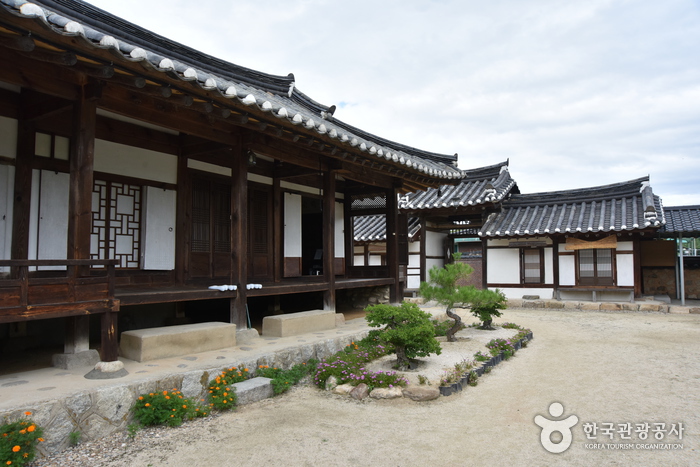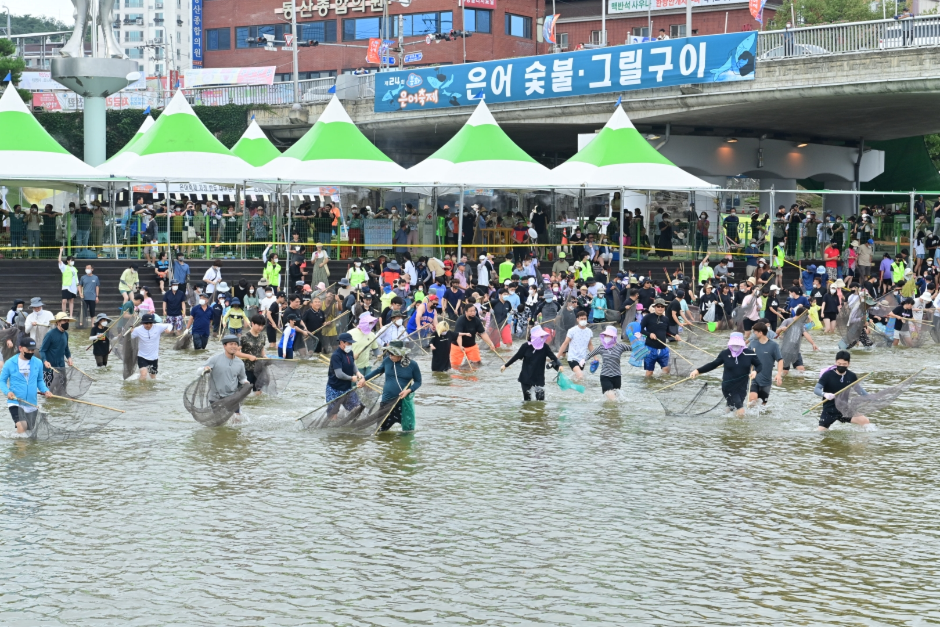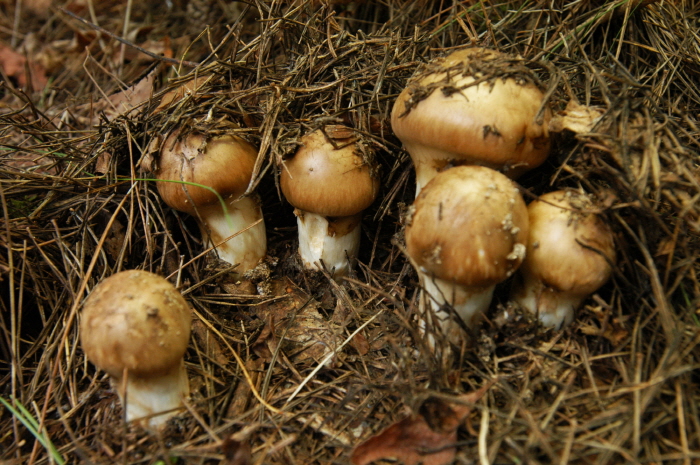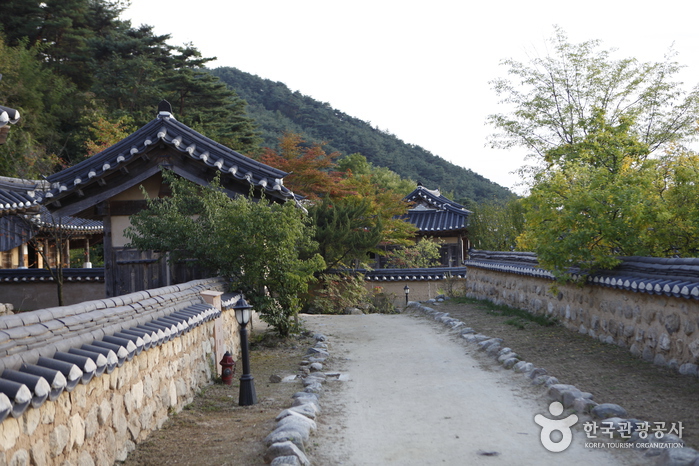Manhoegotaek [Korea Quality] / 만회고택 [한국관광 품질인증]
0m 3568 2020-09-08
51, Baraemi 1-gil, Bonghwa-eup, Bonghwa-gun, Gyeongsangbuk-do
+82-54-673-7939, +82-10-7424-7280
Manhoe Historic House is located in the village of Baraemi, whose name means “a village under the sea.” As a place where literary and intellectual endeavors have flourished since ancient times, Manhoe Historic House’s representative structure is Myeongwolu Pavilion, where ancestors studied and recited poetry amid the beautiful landscape of Sobaeksan Mountain. It is said that about 1,000 poems were composed at the pavilion in the old days.
The house is also the birthplace of the independence movement in Korea. Local Confucian scholars led by Independence activist Kim Chang-suk gathered together at the pavilion right after the March 1st Movement in 1919 and wrote the petition for Korea’s Independence, which was eventually submitted to the Paris Peace Conference. Recently, many hundreds of letters exchanged between independence activists were also discovered at the house.
The house is a square-shaped hanok structure consisting of a ‘ㄷ’-shaped anchae (women’s quarters), a ‘ㅡ’-shaped sarangchae (men’s quarters), a jungmunganchae (middle gate building), and a courtyard. The anchae, which is over 320 years old, has been inhabited by the descendants of Kim Geon-su, a civil official of the late Joseon period, for six generations, The sarangchae, which is over 200 years old, was added to the original house at a later date.
The house was mainly built with red and solid Chunyang pine wood, and is well preserved as a result. The sarangchae has a half-hipped roof, and comprises a sarangbang (main room), daecheong (main floored room), geonneonbang (a room opposite the main room), and toenmaru (a narrow wooden porch running along the outside of the building). The guestrooms of the sarangchae and jungmunganchae include the Sarangbang, Seonangsil, and Baraemisil Rooms, of which the Sarangbang and Seonangsil are equipped with an individual indoor bathroom.
In particular, the anchae is a cozy well-insulated building comprising a daecheong in the middle, a sangbang room on the left, and a gobang (storeroom) and anbang (main room) on the right.
Every room of the anchae is decorated with paintings by the owner’s daughter, fabric artworks, and antique wooden furniture. The anbang, which has an attic and indoor bathroom, can accommodate up to eight people. Guests of the sangbang and gobang need to use the external bathroom.
Right next to the house is a farm covering an area of 6,600m2 where over 100 kinds of crops are cultivated organically, including wildflowers, sweet potatoes, tomatoes, corns, peanuts, salad leaves and other vegetables, which are available for guests. Although the house doesn’t provide a breakfast, guests can pick vegetables in the field and cook them in the communal kitchen or at the BBQ facility in the outer yard. Meanwhile, the nearby Songyigukbapjip restaurant specializes in the delicious local dish made with pine mushrooms.
The house provides a variety of traditional experience activities including Tuho (stick throwing), Seunggyeongdo (chess), Neolttwigi (Korean jumping game similar to see-saw), Sijo composition (traditional Korean three-verse poem), a traditional musical instrument experience (six-stringed Korean zither, seven-stringed instrument, gong, etc.), and a woodblock printing experience.
Tohyang traditional house [Korea Quality] / 토향고택 [한국관광 품질인증]
80.11374741279091m 10790 2020-09-10
43, Baraemi 1-gil Bonghwa-eup, Bonghwa-gun, Gyeongsangbuk-do
+82-10-8575-9036
This historic house has been the home of the descendants of Kim Yeo-byeong, one of the tenth-generation ancestors of its current occupants. Kim Yeo-byeong was born as the fourth son of Kim Seong-gu (courtesy name: Oheon, 1641-1707), founder of Uiseong Kim's Clan at Baraemi Village in Bonghwa and who was a great-great-great grandson of eminent Neo-Confucian official-scholar Kim U-goeng (courtesy name: Gaeam, 1524-1590). The house is comparatively large, featuring a square layout with a lofty five-bay gate building (soseuldaemun) and the main house of seven bays. The main building (anchae) of the house, located against the backdrop of a pine hill, is believed to have been built over 400 years ago before the founder of the family arrived at the village. The family guesthouse (sarangchae) was renovated in 1876 by Kim In-sik (courtesy name: Amun, 1855-1910), who served as the caretaker (Chambong) of Sunghyejeon Shrine, and Grand Master Tonghun before founding Joyang School, which would later become the present-day Bonghwa Elementary School. The name of the house, Tohyang, came from the courtesy name of Kim Jung-uk (1924-1967), a grandson of Kim In-sik. The latter was conscripted by the colonial authority ruling Korea at the time to serve the Japanese puppet state Manchukuo but fled during a military drill to become a freedom activist fighting against Imperial Japan in the Chinese cities of Suzhou and Hangzhou. He returned home after the 1945 Korean Liberation and studied in Jungang High School and Korea University before serving as a budget officer at the Economic Planning Board. The name of the house inscribed on the plaque hung under the roof of the gatehouse was written by his son Kim Jong-gu in honor of his life and achievements. At the front courtyard of the house is a lotus pond including barbecuing equipment and pottery kiln. In the rear garden is a folk playground with facilities and equipment for swinging, traditional Korean seesaw, shuttlecock-kicking, pitch-pot, and top spinning. The front courtyard also features rustic ceramic pots and rooftiles bearing poetic passages written by the mistress of the house who is a prize-winning poetess. The house provides visitors with an opportunity to experience traditional Korean cultural heritage such as pottery, calligraphy, poetry, and traditional musical instruments. Rich with the heritage of traditional Korean culture and lifestyle, the Historic House of Tohyang guides visitors to refreshment and healing obtained from the legacy of the peaceful rural life of days gone by.
The Namho house [Korea Quality] / 남호구택 [한국관광 품질인증]
459.83624829029236m 117 2020-09-03
21, Baraemi-gil, Bonghwa-gun, Gyeongsangbuk-do
+82-54-673-2257
Located in Bonghwa-eup, Bonghwa-gun, Gyeongsangbuk-do, Bonghwa Namho Gutaek is an old house from the Chosun period designated as Cultural Property Material No. 385. It was built by Nongsan Kim Nam Yeong in 1876 and his son Namho Kim Roe Sik had lived there. Mr. Kim Roe Sik was awarded with a medal for contributing his entire asset to military fund for the Provisional Government of Korea. The spirit of putting others and his country before himself continues until now. Having been built with high-quality materials, the 140-year old Namho Gutaek has barely suffered any deformation. In addition, attentive care added by the descendants has kept the traditional beauty of the hanok intact. One may even feel reverence at the Sosel Daemun (gate). In harmony with the hanok, the garden in the yard and the flower bed sitting next to the wall change color as season changes. It is a great place to feel the scent of old trees and get some rest. In 2016, the shared toilet was renovated in modern style to alleviate any inconvenience for the guests. In the spacious yard, there’s a spot for traditional games such as Tuho, Jegichagi, Neoltuigi, etc. Bonghwa Station (Yeongdong Line) is about a 15- minute walk away; an inner city bus stop in the town, on the other hand, makes a trip to other regions easy.
Sogang House
487.5186883623519m 5128 2021-04-09
22, Baraemi-gil, Bonghwa-eup, Bonghwa-gun, Gyeongsangbuk-do
+82-10-9189-5578
The House of Sogang is an approximately 110-year-old house located in the village of Baraemi in Bonghwa-gun, Gyeongsangbuk-do. It was originally built for and presented to Kim Chang-gi (pen-name: Sogang), a well-known local Confucian scholar who served as the head of the Dosanseowon Confucian Academy, and who happened to be the second son of Kim Roe-sik (pen-name: Namho), the great-grandfather of the current owner.
Furthermore, the House of Namho, which is situated behind the House of Sogang, was built for the first son of Kim Roe-sik, one of the richest men in the region, who borrowed money using his entire property as security and donated it to a war chest. He won an official commendation for his role in helping secure national independence in 1977.
The entire village pf Baraemi is composed of traditional square-shaped houses with tiled roofs set amid a clean and peaceful atmosphere, for which it was designated as a Traditional Cultural Village way back in 1922. The name of the village, Baraemi, implies that it was originally situated by the sea, and many shell remains have been found in paddy fields and puddles there over the last 60 years.
The House of Namho is a typical square-shaped house with a tiled roof, and comprises a tall gate, a front courtyard, a sarangchae (men’s quarters) with maru (wooden floor), an inner courtyard, and a bonchae (main building) among its various structures. The main construction material of the house is Chunyang pine wood, which is a rarely used these days. Thanks to the owner-family’s dedicated maintenance and care, the house has been preserved in good condition. As the typical residence of a nobleman of the late Joseon period, the house is decorated with simple interior objects including an old electric fan and a cabinet inlaid with mother-of-pearl.
The house has seven guestrooms in total: The sarangchae consists of the Keunsarang and Jakeunsarang, each with a capacity of 4 to 5 people, and the Araetbang with a capacity of 2 to 3 people. In summer, guests can rent the Jakeunsarang and Sarangdaecheong together, or the Araetbang and Marutbang together, in order to have more space.
In addition, the anchae has a sangbang with a capacity of 3 to 4 people, while the mugangchae consists of Mungangbang 1, which is a red clay floor-heated room, and Mungangbang 2, which can accommodate 2 to 5 people. In summer it is possible to rent the entire House of Sogang, which can accommodate anywhere from 22 to 34 people (if the Sarangmaru and Marutbang are also rented).
Guests of the Keunsarang and Jakeunsarang can use a communal refrigerator, and the entire building has Wi-Fi access. Clean bedding is also provided. Although the house doesn’t provide a breakfast, the owner offers guests sweetcorn, sweet potatoes, fruit, etc. The house is also equipped with a BBQ facility, so guests can enjoy a BBQ party in the evening.
Guests can easily reach various nearby cultural heritage sites, including Muryangsujeon Hall of Buseoksa Temple, Sosuseowon Confucian Academy, which was the first Confucian Academy of Korea, Ojeon Mineral Spring, Daksil Village, and Chukseosa Temple.
Festival del Pez de Agua Dulce de Bonghwa (봉화은어축제)
2.2 Km 2826 2024-02-28
Naeseong-ri, Bonghwa-eup, Bonghwa-gun, Gyeongsangbuk-do
054-674-3053
El Festival del Pez de Agua Dulce de Bonghwa, que se celebra en el municipio de Bonghwa-gun, en la provincia de Gyeongsangbuk-do, ofrece numerosos programas interactivos que incluyen la pesca de pez dulce, carreras bajo agua y concursos de preguntas. La pesca del pez dulce, que tiene lugar dos veces al día en días laborables y tres veces los sábados, es la actividad más famosa del festival. Los ganadores de las carreras bajo agua y de los concursos de preguntas reciben especialidades locales como premio. Además, hay varios eventos educativos y culturales, tales como una exhibición de diversas especies de peces, un centro ecológico sobre el pez dulce en el que los visitantes pueden observar el hábitat natural del pez, el Museo de Moneda Coreana, el Centro Turístico Fotográfico de Bonghwa, pinturas sobre el pez dulce, cerámica, artesanías de hanji (papel tradicinal coreano), e inscripción en piedras.
Festival del Songi de Bonghwa (봉화송이축제)
2.3 Km 18192 2024-02-28
Naeseong-ri, Bonghwa-eup, Bonghwa-gun, Gyeongsangbuk-do.
054-674-3053
Las setas songi (setas del pino) de Bonghwa están consideradas una especialidad de primer orden. Estas setas crecen solo en los pinos llamados chunyangmok, y pueden ser almacenadas durante largos períodos de tiempo. Durante el Festival del Songi de Bonghwa, los visitantes pueden ver estas setas en su hábitat natural e incluso tener la oportunidad de recolectarlas. También se pueden probar varios licores y especialidades locales elaborados a partir de las deliciosas setas songi.
Hamheung Myeonok (함흥면옥)
11.3 Km 99 2016-09-05
Jungang-ro 109-10, Yeongju-si, Gyeongsangbuk-do.
Hamheung Myeonok is a family operated business for three generations mainly serving ‘naengmyeon’ (cold noodles) and ‘galbi’ (grilled ribs).
A well-known place in Yeongju, Hamheung Myeonok offers the second floor especially for groups.
Cleanliness and hygiene are most emphasized by the owner.
Hand kneaded cold noodles are extra chewy and their North Korean style ‘bulgogi’ (marinated barbeque beef) are quite famous.
Also, try their ‘galbi Jjim’ (marinated and simmered ribs) which is combined with Korean herbal medicine providing a healthy dining choice for visitors.
Excellent service, atmosphere and food.
Overall a superb restaurant.
Templo Buseoksa (부석사) [Patrimonio de la Humanidad de la Unesco]
11.5 Km 4684 2022-05-02
Buseoksa-ro 345, Buseok-myeon, Yeongju-si, Gyeongsangbuk-do.
El templo Buseoksa es un templo “masculino”. Se diferencia de otros templos por su dimensión y su hermoso y fresco panorama. El templo Buseoksa fue construido en 676, durante el reinado de Munmu (661-681) en la dinastía Silla (57 a.C – 935 d.C) por el fundador Uisang (625-702) bajo las órdenes del rey. Luego, en el 7mo. año (1016) de la dinastía Goryeo (918-1392), bajo el reinado de Hyeonjong (que reinó de 1010-1031) el gran monje budista Wonyung (964-1053) restauró el pabellón Muryangsujeon (Tesoro Nacional), que luego fue restaurado varias veces.
La leyenda de la dama Seonmyo y Uisang es muy conocida. Estos dos personajes se conocieron cuando el monje Uisang viajó a China a realizar sus estudios. Cuando Uisang le dijo a Seonmyo que volvería a su país, Seonmyo se tiró al mar y se ahogó y se convirtió en un dragón. Seonmyo siguió a Uisang hasta Silla para protegerlo y estar con él. Cuando Uisang era perseguido por la multitud que se reunía para detenerlo frente al templo Buseoksa, Seonmyo lanzó tres rocas al aire. La roca quedó del lado izquierdo del pabellón Muryangsujeon. Por el tamaño y forma plana de esta roca, el templo recibió el nombre de Buseoksa (buseok significa "roca flotante").
En la entrada de Buseoksa podrá ver 108 escalones entre las puertas Cheonwangmun y Anyangmun. El número de escalones representa la redención de sentimientos malvados y de agonía a través de 108 ciclos. Pasando por las puertas Iljumun y Cheonwangmun, se encontrará con la torre de tres pisos del templo. Sobre la torre podrá ver el Beonjongru y luego podrá ver el pabellón llamado Anyang, que significa ‘entrada al cielo’. Pasando el pabellón Anyang llegará al edificio principal del templo Buseoksa, Muryangsujeon, que cuenta con hermosas líneas curvas de la estructura del edificio. Muryangsujeon es un edificio de madera construido en la dinastía Goryeo. En su interior, encontrará la figura de Sojo Yeorae (Tesoro Nacional) y otras reliquias como el Josadang (Tesoro Nacional), el mural Josadang (Tesoro Nacional) y la linterna de piedra (Tesoro Nacional) frente a Muryangsujeon.
Aldea de Eruditos Seonbichon (선비촌)
12.2 Km 5030 2022-09-20
Sobaek-ro 2796, Sunheung-myeon, Yeongju-si, Gyeongsangbuk-do
Siendo un lugar que congrega el espíritu histórico de los eruditos confucianos de la antigüedad, ubicado en Yeongju, de la provincia de Gyeongsangbuk-do, es un espacio académico en donde podrá experimentar la cultura tradicional de la región y del país. Los turistas extranjeros tienen una amplia variedad de programas atractivos para participar, entre ellos, elaborar el tteok (pasta de arroz), recorrer con el farol tradicional de color rojo y azul cheongsachorong, representación de la boda tradicional, experimentar los juegos foclóricos yunnnori (lanzar palos al aire), jegichagi (dar puntapiés a una borla), visitar un museo, etc. Además, en los puestos callejeros, tendrá la posibilidad de degustar los platos tradicionales. Es más, la diversión no termina aquí, en las casas tradicionales, también podrá alojarse y experimentar la cultura del país, mediante las actividades académicas y espectáculos relacionados a los protocolos y tradiciones que hoy en día se encuentran olvidadas. En sus cercanías están la Academia Neoconfuciana Sosu Seowon, el Museo Sosu y el templo Buseoksa, entre otros destinos turísticos.
Museo Sosu (소수박물관)
12.3 Km 5231 2021-03-05
Sobaek-ro 2780, Sunheung-myeon, Yeongju-si, Gyeongsangbuk-do
+82-54-639-7691
El Museo Sosu pretende consolidar y organizar el legado confucionista de la nación y establecer la raíz de su espíritu a través de Sosu Seowon, la primera academia neoconfuciana creada en Corea. Es el único museo donde se puede experimentar el legado de esta cultura y su historia durante la dinastía Joseon. El museo abrió el 22 de septiembre de 2004 y desde entonces ha sido un lugar para aprender con las reliquias del confucianismo.
![Manhoegotaek [Korea Quality] / 만회고택 [한국관광 품질인증]](http://tong.visitkorea.or.kr/cms/resource/64/2579364_image2_1.jpg)
![Tohyang traditional house [Korea Quality] / 토향고택 [한국관광 품질인증]](http://tong.visitkorea.or.kr/cms/resource/57/2627457_image2_1.jpg)
![The Namho house [Korea Quality] / 남호구택 [한국관광 품질인증]](http://tong.visitkorea.or.kr/cms/resource/90/2626090_image2_1.jpg)




![Templo Buseoksa (부석사) [Patrimonio de la Humanidad de la Unesco]](http://tong.visitkorea.or.kr/cms/resource/22/2654222_image2_1.jpg)

 Español
Español
 한국어
한국어 English
English 日本語
日本語 中文(简体)
中文(简体) Deutsch
Deutsch Français
Français Русский
Русский